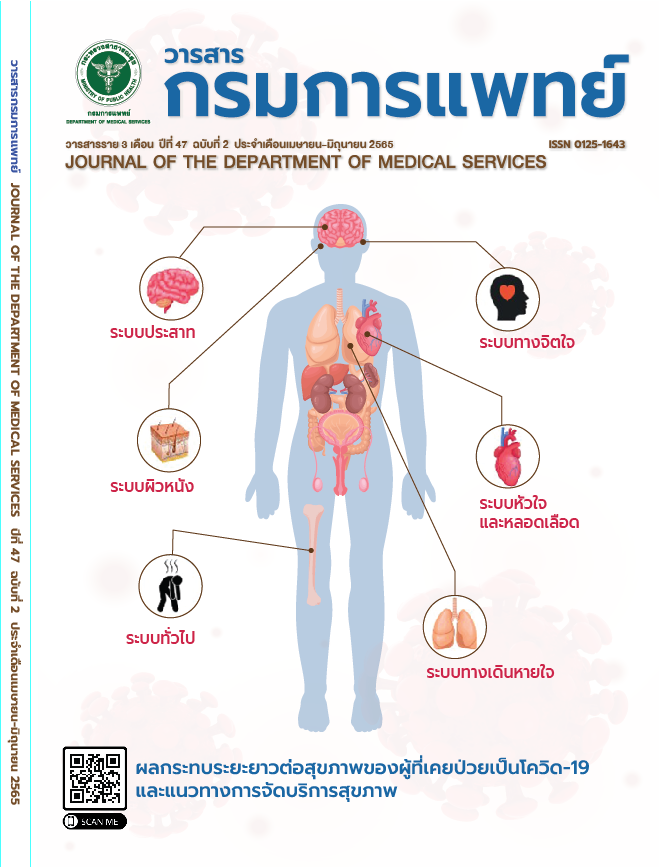ปัจจัยเสี่ยงของการเสียชีวิตของทารกที่มีภาวะสูดสำลักขี้เทาในโรงพยาบาลตรัง
คำสำคัญ:
ภาวะสูดสำลักขี้เทา, ขี้เทาปนในน้ำคร่ำ, ทารกที่ไม่ตื่นตัวดีหลังคลอดบทคัดย่อ
ภูมิหลัง: ภาวะสูดสำลักขี้เทา(Meconium aspiration syndrome; MAS) เป็นสาเหตุสำคัญของภาวะหายใจลำบากในทารกแรกเกิดและมีภาวะแทรกซ้อนที่รุนแรงและเป็นสาเหตุการเสียชีวิตที่พบมาก วัตถุประสงค์: เพื่อหาอุบัติการณ์ของการเกิดภาวะสูดสำลักขี้เทาในทารกแรกเกิดใน โรงพยาบาลตรัง และศึกษาผลการรักษา รวมถึงปัจจัยที่มีผลต่อการพยากรณ์โรคและการเสียชีวิต วิธีการ: เป็นการศึกษาเชิงพรรณนาแบบย้อนหลัง โดยทบทวนข้อมูลจากเวชระเบียนของทารกที่ได้รับการวินิจฉัยภาวะสูดสำลักขี้เทาในโรงพยาบาลตรังตั้งแต่วันที่ 1 ตุลาคม พ.ศ.2559 ถึงวันที่ 30 กันยายน พ.ศ.2562 รวบรวมข้อมูลพื้นฐานของทารกและมารดา อาการ การรักษาและ ผลการรักษา ผล: จากจำนวนทารกที่มีขี้เทาปนในน้ำคร่ำ 556 ราย วินิจฉัยภาวะสูดสำลักขี้เทา (MAS) 203 ราย (ร้อยละ 36.5) คลอดใน รพ.ตรัง 159 ราย คิดเป็นอุบัติการณ์ 14.76 รายต่อ 1000 ทารกเกิดมีชีพ เสียชีวิต 15 ราย (อัตราตายร้อยละ 7.4) ร้อยละ 38.9 ต้องใช้เครื่องช่วยหายใจ ภาวะแทรกซ้อนที่พบบ่อยมากที่สุด ได้แก่ Persistent Pulmonary Hypertension of newborn ; PPHN (ร้อยละ 100) และ sepsis (ร้อยละ 87.6) ปัจจัยที่มีผลต่อการเสียชีวิตอย่างมีนัยสำคัญ ได้แก่ ทารกที่ไม่ตื่นตัวดีหลังคลอด, APGAR score ที่ 1 นาที และที่ 5 นาทีน้อยกว่า 3 , ทารกที่ต้องใช้เครื่องช่วยหายใจ และทารกที่มีภาวะแทรกซ้อน ได้แก่ PPHN , sepsis , pneumothorax และ pulmonary hemorrhage สรุป: พบอัตราการเกิด MAS 14.76 รายต่อทารกเกิดมีชีพ 1000 ราย อัตราตาย ร้อยละ 7.4 ปัจจัยที่มีผลต่อการพยากรณ์โรค คือ ทารกที่ไม่ตื่นตัวดีหลังคลอด , ขาดออกซิเจนปริกำเนิดรุนแรง , ทารกที่ต้องใช้เครื่องช่วยหายใจ และทารกที่มี PPHN , sepsis , pneumothorax และ pulmonary hemorrhage สาเหตุการตายเกิดจาก PPHN มากที่สุด
เอกสารอ้างอิง
Fanaroff AA. Meconium aspiration syndrome: historical aspects. J perinatal 2008 ; 28 : supply 3: s3-7.
Wiswell TE,Bent RC. Meconium staining and the meconium aspiration syndrome. Pediatr Cli North Am 1993;40: 955-81.
Cleary GM, Wiswell TE. Meconium-stained amniotic fluid and the meconium aspiration syndrome: An update. Pediatr Clin North AM 1998; 45:511-29.
Klingner MC, Kruse J. Meconium aspiration syndrome: pathophysiology and prevention. J Am Board Fam Pract 1999; 12: 450-66.
Khorana M. Meconium aspiration syndrome.In :Punnahitanon S, Ngerncham S, Limrungsikul A ,eds. .Highlights in Neonatal Problems. Bangkok : Active print Co.Ltd, ; 2018. p 371-89.
Tsu F. Yeh. Core Concepts: Meconium aspiration syndrome: Pathogenesis and Current Management. Neoreview 2010 ;11;e503-11.
Engsirorat M. Outcome of Meconium aspiration syndrome in Udonthani Hospital. Thai J Pediatr 2018; 57: 43-50.
Chewaproug S. Risk Factor of neonatal Death in Meconium aspiration syndrome at PathumThani hospital. J Health sci 17.1 (2015): 46-56.
Siriyotiphan S. Risk Factor of Neonatal Death on Meconium Aspiration Syndrome in Prachuapkhirikhan Hospital. Reg 4 Med J 2000; 19(1):43-53.
Boonluksiri P, Nimdej K. Incidence and risk factors of meconium aspiration syndrome at Hatyai Hospital Songla Med J 2003; 21: 179-86.
International Liaison Committee on Resuscitation. 2005 International Consensus Conference on Cardiopulmonary Resuscitation and Emergency Cardiovascular Care Science With Treatment Recommendations Part 7 : Neonatal resuscitation. Circulation 2005;112:III-91-9.
Kattwinkel J, Perlman JM, Aziz K , Colby C, Fairchild K, Gallagher J , et al Part 15: Neonatal Resuscitation 2010 American Heart Association Guidelines for Cardiopulmonary Resuscitation and Emergency Cardiovascular Care. Circulation 2010; 122:S909-19
Wyckoff MH, Aziz K, Escobedo MB, Kapadia VS , Kattwinkel J, Perlman JM, et al. Part 13 : Neonatal resuscitation:2015 American Heart Association Guidelines Update for Cardiopulmonary Resuscitation and Emergency cardiovascular Care. Pediatrics. 2015; 136: S196-218.
Jirapradittha J. Routine endotracheal suction is no longer recommended for non vigorous neonates born through meconium stained amniotic fluid, whether it is proper or not : An evidenced-based literature review. Thai J Pediatr 2016; 55: 226-38.
Zahid A, Tayyaba KB, Fariha A, Muhammad YK. Mortality in meconium aspiration syndrome in Hospitalized Babies. J Coll Phys Surg Pakistan 2011; 21:695-9.
L Panton, H Trotman. Outcome of neonatal with Meconium aspiration syndrome at the university Hospital of the West indies , Jamaica : A resource-limited setting .Am J perinatal 2017; 34: 1250-4.
Espinheira M, Grilo M, Rocha G, Guedes B, Guimaraes H. Meconium aspiration syndrome-the experience of tertiary center. Revista port de pneumo; 2011; 17:71-6.
Dargaville PA , Copnell B; for the Australian and New Zealand Neonatal Network. The Epidermiology of meconium aspiration syndrome : incidence , risk factor, therapies ,and outcome. Pediatr. 2006; 17:1712-21.
Trainak S, Siwadune T. Factor Association with Meconium aspiration syndrome in Cases with meconium-stained Amniotic fluid. TJOG 2016; 24:240-6.
Singh BS, Clark RH, Powers RJ, Spitzer AR. Meconium aspiration syndrome remains a significant problem in the NICU: outcomes and treatment patterns in term neonates admitted intensive care during a ten-year period. J Perin. 2009; 29: 497-503.
ดาวน์โหลด
เผยแพร่แล้ว
รูปแบบการอ้างอิง
ฉบับ
ประเภทบทความ
สัญญาอนุญาต
ลิขสิทธิ์ (c) 2022 กรมการแพทย์ กระทรวงสาธารณสุข

อนุญาตภายใต้เงื่อนไข Creative Commons Attribution-NonCommercial-NoDerivatives 4.0 International License.
บทความที่ได้รับการตีพิมพ์เป็นลิขสิทธิ์ของกรมการแพทย์ กระทรวงสาธารณสุข
ข้อความและข้อคิดเห็นต่างๆ เป็นของผู้เขียนบทความ ไม่ใช่ความเห็นของกองบรรณาธิการหรือของวารสารกรมการแพทย์



